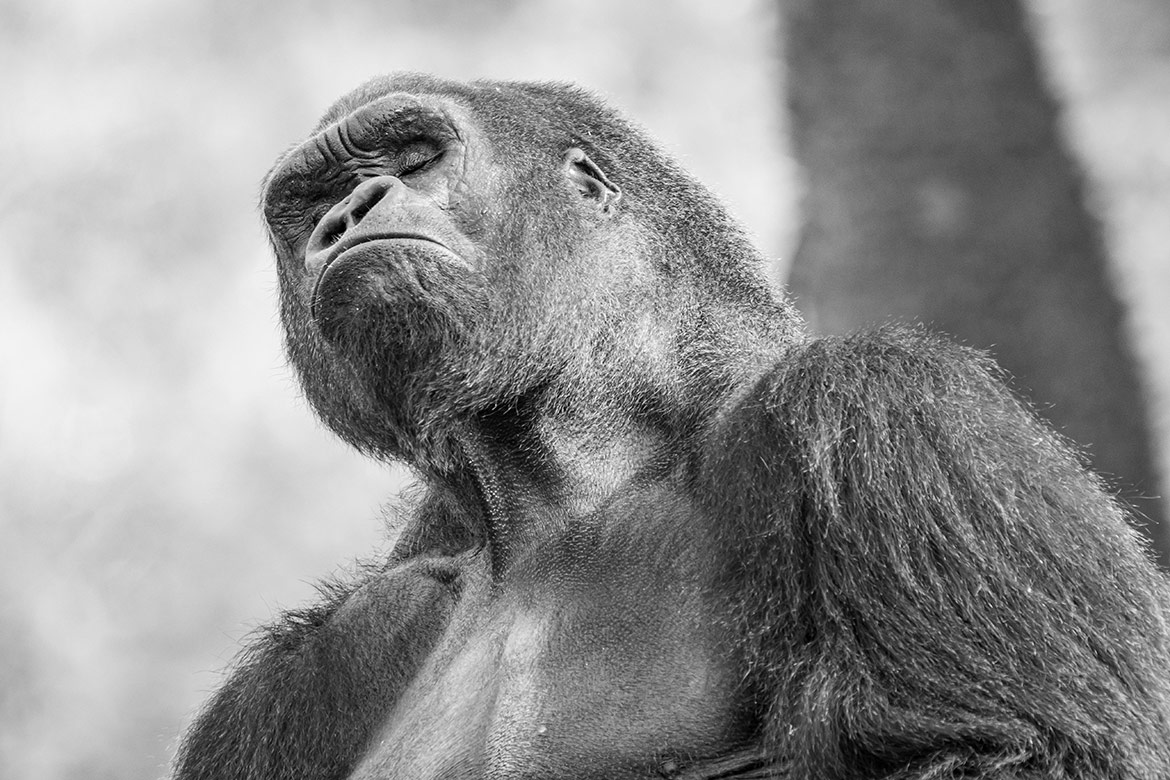EVOLUTION
A funny kind of ape
As scientists try to boost our understanding of what distinguishes humans from other apes, the clues become increasingly misleading. We investigate chimps, bonobos and gorillas.

How similar gorillas are to us human beings! And yet the years our species spent in the savannah changed us significantly. | Photo: Shutterstock
A sequence of figures known as the ‘March of Progress’ shows a quadruped ape standing up straight to become Homo sapiens, walking upright on two legs. This famous image teaches people about the theory of evolution. Although it recalls our descendancy from apes, it provides the incorrect impression that we sit atop the peak of evolution and that gorillas, bonobos and other chimps are our ancestors.
We’re all cousins
In fact, they have continued to evolve since our last common relative. “We mustn’t forget we are a species of great ape. Nor take it badly”, says Thibaud Gruber, a professor of psychology at the University of Geneva and a co-director of the Bugoma Primate Conservation Project in Uganda. We are indeed closer to chimpanzees genetically than they are to gorillas, but Gruber dismisses the question of who most resembles whom. “We’re all cousins, with a number of common traits and specificities that have developed in each species”, he says insistently.
Multiple studies show that certain apes display characteristics long considered as unique to our species: the use of tools, personality, empathy, social structures and group-specific culture. Gruber delves into the notion of culture as understood by evolutionary biologists. It encompasses the behaviours resulting from neither innateness nor instinct and which are transmitted through group learning. For instance, to wash certain food or to use sticks to extract honey from a tree trunk. With regard to observing the differences among clans, Gruber underlines the importance of also studying primates in their natural habitats.
This point is also raised by Kathelijne Koops, a professor of anthropology and a specialist in behavioural evolution at the University of Zurich who works regularly on the ground in Africa. She studies learning in the great apes, including humans, and is interested especially in the use of tools, which is normal among chimps and largely absent from gorillas and wild bonobos. “The social and natural environments play a role in these behavioural differences”, she says. “For example, we see how bonobos can indeed learn to use tools in captivity. It remains a mystery why they don’t in the wild”.
Our closest primate cousins communicate, live according to precise social rules, can use tools and are influenced by group culture. That said, there are differences that separate us. “Throughout evolution, something in humans spiralled off, and we followed our own path and changed dimension”, says Gruber. “A relatively recent invention, language, has had an incredible impact on our cognition”. A new ability to conceptualise the world has opened up inside us. For Koops, this acquisition of complex communication might have also impacted things beyond cerebral development, by improving the transmission of knowledge. “Complex technology requires active teaching, learning by observation doesn’t always suffice. Language enables this step to be taken”, she says.
The cooperation hormone
Our aptitude for communicating in complex ways also resonates with Redouan Bshary, an environmental ethologist at the University of Neuchâtel. He puts forward another of the consequences: “What makes us strange compared to other species is that we help strangers. Language and shared intentionality allow us to discover the opportunities of cooperation”. Alongside our language, our skill in imagining what’s going on in another person’s head and realising that we’re both thinking the same thing reflects a central ability to explain the hyper-cooperation seen in humans.
Whilst interested in humans too, Bshary is above all a specialist in fish and has also worked with small apes. He studies the interactions among species and the influence of the environment on their evolution. “Natural selection only looks at the mechanisms that are good for the success of individuals and their genes. When we look at ourselves as a species, it’s about those that are good for cooperation”. Psychological and hormonal mechanisms necessary for this behaviour offer a survival and reproduction advantage and therefore have been selected.
Bshary mentions oxytocin, the bonding hormone that creates the ties between parents and their offspring. “We have diverted this mechanism to enable bonding with partners, friends and other group members”. The very notion of ‘group’ is broad in humans, as it may encompass a football club, a nation or even a religion. They are social structures where our behaviours tie into biological altruism: helping others leads to direct or indirect benefit. “The sense of justice, morals, empathy . . . Part of our desire to be nice is physiological. It works to boost our cooperation, in the interest of individuals and their genes”.
H. sapiens is therefore the result of a vertiginous evolutionary spiral. A larger brain, higher levels of cognition, language, shared intentionality and cooperativeness are all factors that may have been crossroads or incremental steps. They are traits that accompanied the use of tools and increasingly complex technologies. “There’s no need to reinvent the wheel with each generation. It only takes a few geniuses and a large capacity to cooperate for the entire group to be pushed forward”, says Bshary.
Morally biased research
To understand why chimpanzees, bonobos and gorillas didn’t follow the same path, it must be recalled that genetics exist in context. “It’s ecology that separates us from the other apes”, says Bshary. Selective pressure drastically changes according to the environment, for instance between tropical forests and the savannah. This may explain the major evolutionary differences over such a short period. “We needed roughly seven million years to separate from chimpanzees and bonobos. But our brain only expanded some 300 thousand years ago”, he says. Humans were therefore only able to merge into their unique evolutionary fast lane thanks to a series of circumstances, a high-performance fuel blended from genes and environment.
There’s no clear response to the question on whether language and augmented cooperativeness are directly beneficial to survival and reproduction or whether they are collateral effects of other characteristics selected by evolution. “We must admit that we don’t know a lot about what happened; cognitive capacities do not fossilise in remains”, says Rebekka Hufendiek, a specialist in human nature and theory of mind.
Hufendiek is a professor in philosophical anthropology at Ulm University (Germany) and also sees potential pitfalls in trying too hard to understand our differences from other animals: “In describing what truly makes us human, authors often seem to set a focus on features that they find fascinating and morally desirable”. To maintain an unbiased and comprehensive vision, we should therefore consider the full range of factors together and avoid at all costs seeking a distinct, decisive element.
Indeed, this idea finds consensus among the four specialists. They also agree that, when defining which human idiosyncrasies explain our uniqueness and how they evolved, it remains less about facts than about opinions. Their viewpoints converge too around the final thoughts of Gruber: “No one may deny that humans are different. We are probably the only ones to ask ourselves about our place in the universe”. We might almost forgive the ‘March of Progress’ for having made us think we were special.




